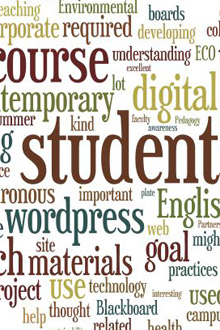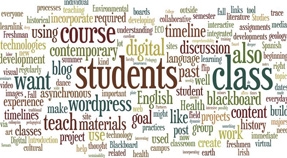

A word cloud of participants' goals for Emory College Online 2012.
Anne Hall's dogs were staring at her expectantly, ready for a walk now that she was home from class. But the senior lecturer in environmental studies was absorbed in testing out VoiceThread, a collaborative multimedia tool that she may apply to her fall geology course to enhance teaching and learning.
It was one of the many technologies and instructional methods that Hall and 10 other faculty participants had learned about that day in Emory College Online, a program offered each summer by the Emory Center for Interactive Teaching (ECIT) that gives faculty hands-on training in creating tangible teaching tools or digital course content.
After class, Hall was eager to dive in. In VoiceThread, she uploaded images of landscapes that illustrate geologic structures. She linked video or text commentary to each image. The VoiceThread writing tool allowed her to record instructional comments while sketching on the image, outlining crystal boundaries or fault traces, for example. Students would then be able to add their comments to the discussion, and create their own image analysis.
"VoiceThread allows me to provide instruction that is accessible outside of class, providing a model for students to analyze geologic features and processes," she says. "A picture is worth a thousand words, and VoiceThread seems like a fabulous way to reinforce what I'm teaching. I think the students will really like it."
Emory College Online 2012, held June 18-22, brought together faculty from various disciplines in Emory College of Arts and Sciences to explore strategies for engaging students in course concepts and discuss ways of assessing learning outcomes.
ECIT has offered the annual summer program for over a decade. The focus of this year's seminar was to explore technological tools and pedagogical methodologies that sustain dialogue in and out of the classroom.
Topics covered included data visualization, social networking, digital storytelling and virtual collaboration. Faculty explored tools such as Twitter, Storify, VoiceThread, iTunes U and Dipity, discussion boards and blogs.
"One of our key objectives was to make sure that everything in the seminar is anchored with teaching and learning in mind, vs. just 'here's the latest coolest technology,'" explains ECIT Director Wayne Morse.
As part of their hands-on training, the class used a WordPress blog to share information, collaborate and give each other feedback.
Participants are encouraged to start building content and student assignments for their fall semester courses.
Dance professor Sally Radell wants to use a wiki — a collaboratively created website — to enhance understanding of basic concepts in her introductory-level dance class.
To show how contemporary dance is a mirror of our culture, for example, Radell envisions "using a video clip of a choreographer's work and have students each contribute images or clips that reflect that idea in different parts of our culture, so they can see that it extends just beyond the dance performance space."
"For me it was really helpful to get an overview of the full palette of technology options, and now I feel sufficiently informed and ready to start working with confidence that this is the right technology for me," says Radell.
"I think the technology will make the class more real for my students. And I'm a better teacher because of faculty development courses like this that keep us current on technology and finding the best ways to deliver the material we teach," Radell adds.
